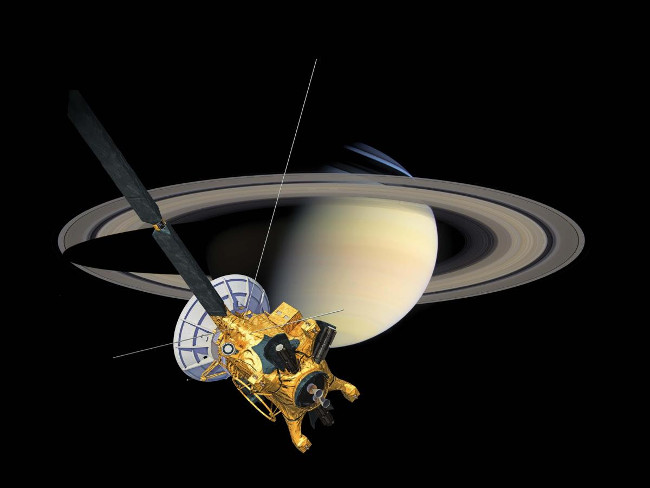NASA's Cassini spacecraft is about to commit suicide on Saturn next week
In the coming week, the Cassini spacecraft will fly through Saturn's atmosphere and crash into the planet's surface after 13 years of discovering its giant planet and moons.
- NASA announces a place that can survive life right in our solar system
- Video: Cassini spacecraft successfully performs the journey around Saturn
- For the first time in history, Cassini obtained strange sounds from Saturn
NASA's $ 3.3 billion Cassini unmanned probe, began to explore Saturn and the moons of this giant planet in 2004. During that time, it flew around the system. Saturn to capture and send to Earth more than 450,000 photos.
 NASA's Cassini spacecraft is about to commit suicide on Saturn next week Picture 1
NASA's Cassini spacecraft is about to commit suicide on Saturn next week Picture 1
When Cassini's fuel is about to run out, the ship's ultimate scientific task is to commit suicide by plunging through Saturn's atmosphere.
Today, September 11, Cassini will receive a gravity push from the Great Moon Titan and begin the journey to collide with Saturn. And at about 3 pm on September 14, Cassini will take the last picture, after which he will make the journey to death. In the process, Cassini remained in contact with the Earth.
At about 5.30 pm on September 15, Cassini will begin to fly through the clouds in the top of Saturn's atmosphere. The ship will slow down, heat up and begin to dive when friction with air increases.
Cassini will catch fire and turn into a fireball through the sky of Saturn. Even in these last moments, Cassini still performed his mission. It will adjust to the Earth and transmit data for as long as possible.
Radio discs in Australia will receive the final signal from Cassini around 6:55 am the next morning. Cassini will then fly for 83 minutes and the onboard system will turn off permanently.
On October 15, 1997, Cassini left Cape Canaveral in Florida, USA and arrived on Saturn on July 1, 2004. It has sent impressive images of Saturn and more than 60 moons of this planet.
Cassini's most important task is to drop the Huygens landing device into Titan - the second largest moon in the solar system, covered by dense nitrogen atmosphere, obscuring lakes and sea surfaces.
Later, Cassini also discovered huge geysers popping up from the southernmost cracks of Enceladus, the tiny frozen ice moon containing a large ocean hidden beneath.
Thus, the researchers determined that Titan and Enceladus were considered one of the most likely places to find the most alien life in the solar system. This is also the reason why Cassini cannot continue to orbit around Saturn because it is difficult to control the risk of collisions with Titan and Enceladus satellites.
You should read it
- Impressive series that Cassini captured before 'suicide'
- Video: Cassini spacecraft successfully performs the journey around Saturn
- Saturn, the most beautiful planet of the solar system through the Cassini spacecraft prism
- Cassini spacecraft, $ 3.26 billion machine 'bombarded' Saturn, ending its 20-year mission
- NASA broadcast live the event of the self-destructive Cassini probe on Saturn at 1732 this afternoon, we can see
- For the first time in history, Cassini obtained strange sounds from Saturn
- 50 images of Saturn's Enceladus moon - where life can exist (Part 1)
- 50 images of Saturn's Enceladus moon - where life can exist (Part 2)
- NASA announces a place that can survive life right in our solar system
- The journey of 20 years in the universe of Cassini through impressive numbers
- NASA: 'Saturn's Titan moon will be our next stop'
- Interesting truth about Saturn
May be interested

If 'stray' to any planet in the solar system, what is your chance of survival?

NASA broadcast live the event of the self-destructive Cassini probe on Saturn at 1732 this afternoon, we can see

How long does one day on the solar system planets last?

The journey of 20 years in the universe of Cassini through impressive numbers

How the Sun will look when viewed from other planets

Strange black planet 'swallowed' 94% of light






 Video: Cassini spacecraft successfully performs the journey around Saturn
Video: Cassini spacecraft successfully performs the journey around Saturn Impressive series that Cassini captured before 'suicide'
Impressive series that Cassini captured before 'suicide' NASA broadcast live the event of the self-destructive Cassini probe on Saturn at 1732 this afternoon, we can see
NASA broadcast live the event of the self-destructive Cassini probe on Saturn at 1732 this afternoon, we can see Saturn, the most beautiful planet of the solar system through the Cassini spacecraft prism
Saturn, the most beautiful planet of the solar system through the Cassini spacecraft prism Cassini spacecraft, $ 3.26 billion machine 'bombarded' Saturn, ending its 20-year mission
Cassini spacecraft, $ 3.26 billion machine 'bombarded' Saturn, ending its 20-year mission For the first time in history, Cassini obtained strange sounds from Saturn
For the first time in history, Cassini obtained strange sounds from Saturn